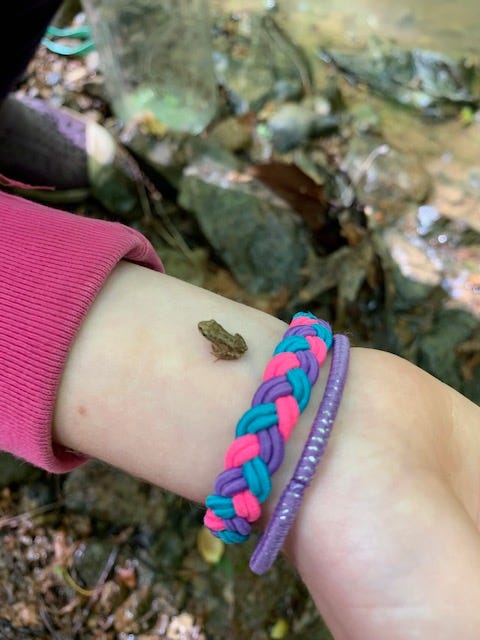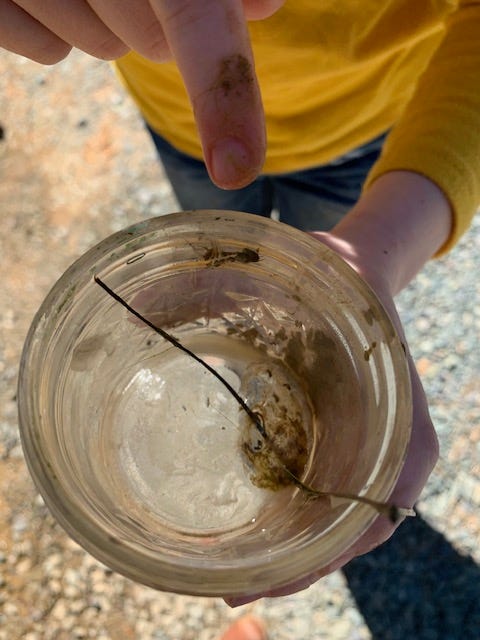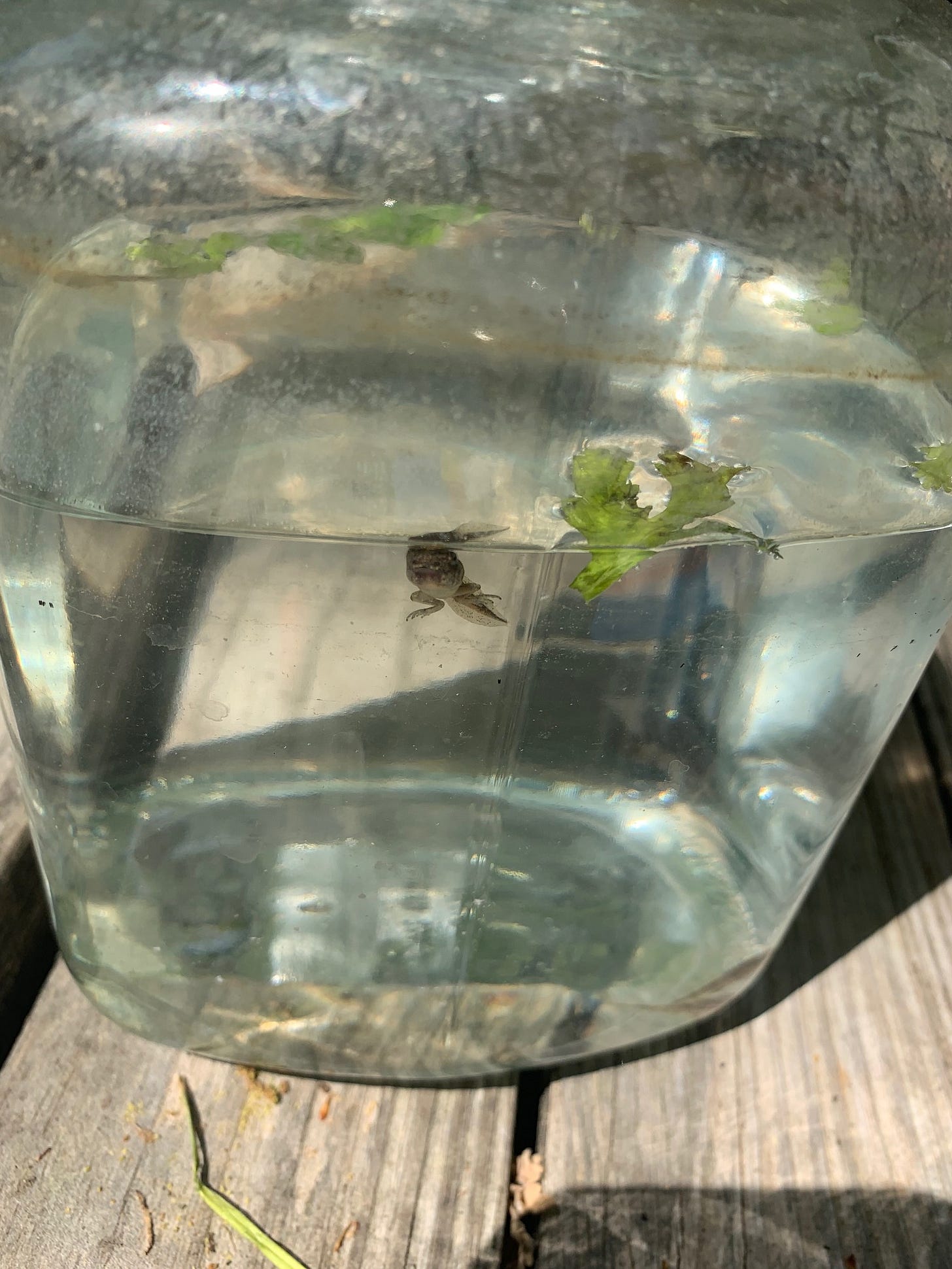(Parents, this Tuesday post is one to give your kids—we know many are home on Wednesdays, or at least Bea is, so the idea is to read it with them, or give it to them to read, on an at-home day. Bea likes to say “no grown-ups allowed!” when she takes over writing club and it becomes witching club, but we’re not going to go that far… yet. Actually, grown-ups/people with an email account or social media, here is the most helpful thing you can do to build this community: send the FTT to someone with a kid!)
For old-times’ sake, take a listen to “Frog Trouble” by Sandra Boynton, performed by Mark Lanegan:
Can you tell what the song is about?
Here’s how Bea explains it: It’s about a cowboy who is trying to make you worry about something coming, specifically frogs. But at a certain point of the song it says, ‘it’s just pretend. I made it all up.’ I think he does that to feel important.
We do know some frogs on a first-name-basis. Seven of them, in fact, which went from swimming around with their tiny legs and shrinking tails in a Mason jar on our deck to gliding across the stream to the safety of rocks and moss: Athena, Artemis, Demeter, Persephone, Freya, Isis, and Oya.
Here is Oya, warrior-queen, about to hop into the stream:
I don’t usually like to let Bea and Harriet “rescue” animals—most of the time, wild animals are better off hanging out and growing in their own habitats. Putting them on your porch or another enclosure can cause them a lot of stress. It can even kill them. But sometimes in the spring and early summer, frogs and toads lay eggs in a shallow puddle that will dry up before the tadpoles become froglets. In that case, it’s good to know about the frog lifecycle, so you can truly get your frogs out of trouble.
Frog lifecycle
Frogs have four life stages.
1. First, they are fertilized eggs, laid by a female frog, in or near water. You can see them in clusters of a clear, jelly-like substance, often in streams, near the edges of ponds, or sometimes in puddles. They look like this:
2. After about two weeks, the eggs hatch into tadpoles. Tadpoles look more like fish than frogs—they have a long tail for swimming, and they breathe underwater, with gills. Over time (this depends on the type of tadpole, how warm it is and how much they have to eat) they develop back legs, and then small front legs, which continue to grow. They start swimming faster and become more agile. Here’s what Athena looked like with back legs:
3. Now they are froglets! Froglets look like tiny frogs with small tails. Their tails get absorbed back into their bodies as energy, and they develop lungs. They still spend most of their time in the water, but once they have front legs, they need to be in shallow water or somewhere they can perch and breathe air.
4. Finally, they are adult frogs, with no tail. They can (and need to) leave the water and eat bugs (including mosquitoes, which is one of the many ways frogs help our environment). Female frogs return to the water to lay eggs, and the cycle starts all over again.
This is a cool video that shows a frog’s life cycle, close up:
Where can I find frog or toad eggs and tadpoles?
You can find eggs and tadpoles in shallow, mostly still water, like ponds, slow-moving streams, and sometimes in puddles. Why do you think that is?
If a mom lays her eggs in a rushing river, they won’t have the right conditions to grow. They might get washed away or carried downstream. We usually find frog eggs and tadpoles in gentle, shallow water. Frog eggs look like dusty sacs of jelly, with tiny black dots inside. Sometimes they cling to a stick or a leaf in the water.
Is it okay to “rescue” tadpoles?
Only if you’re truly rescuing them! What does “rescue” mean?
To rescue someone or something is to save it from danger or death. Are turtles walking around in the woods, minding their turtle business, in need of “rescue”? Nope! Most animals are better off in their natural habitats, no matter how much fun it seems to take them home as pets.
So don’t take tadpoles or eggs from a healthy stream or a pond—their mom put them there for a reason, and this habitat is the best place for them. You can watch them instead, and even take one to examine in a jar or bug box (only if you put it back).
But sometimes, you’ll find tadpoles or egg sacs in a puddle. Why is this a problem?
Yep, the puddle might dry up, and then the eggs will never hatch and any tadpoles will die. Time to act! (See Sunday’s post for a lesson from Bea on how to care for your tadpoles.)
Okay! Time to do some exploring. We like to call everything a club, so let’s call this…Explorers Club!
1. With a grown-up and a notebook and pencil, take a slow walk in your neighborhood, yard, or a park. Look for places where animals live—maybe an ant hill, or a tree that squirrels are playing in, or a pond or puddle (even if you don’t find tadpoles, I bet something is alive in there). Sit near some flowers and you’re pretty sure to see a butterfly or bees (be careful if you’re allergic).
Tip from Bea: If you want to find a frog or a toad in your yard, look in damp or wet places, especially after it rains. Look in trees or on the ground in the grass or under ferns. If you have a spigot, you might have frogs nearby. Look in mucky places too.
2. Sit down next to the animal’s habitat. Sketch or write about what you see and hear--Is anything moving? What makes this place a good animal habitat? Do you see anything that could be a danger to an animal?
OR try to see it from the animal’s point of view! If you are an ant, frog, squirrel, or bird, what do you see, hear, smell, feel, or taste?
3. Tell us what you saw in the comments. (We’re looking for a way to make sharing visual… feel free to email me [belleboggs@gmail] if you want to share a picture!)
Bea and I will check in and do the same!
Friday will have more about frogs, plus some links. In the meantime, here are some good books about frogs and toads and their habitats:
Take-Along Guide to Frogs, Toads, and Turtles by Diane Burns and Linda Garrow.
The Secret Pool by Kimberly Ridley and Rebekah Raye
A Frog’s Life by Nancy Dickmann
Amazing Amphibians by Lisa J. Amstutz
We’re so curious about what you saw outside in your environment, so please…






